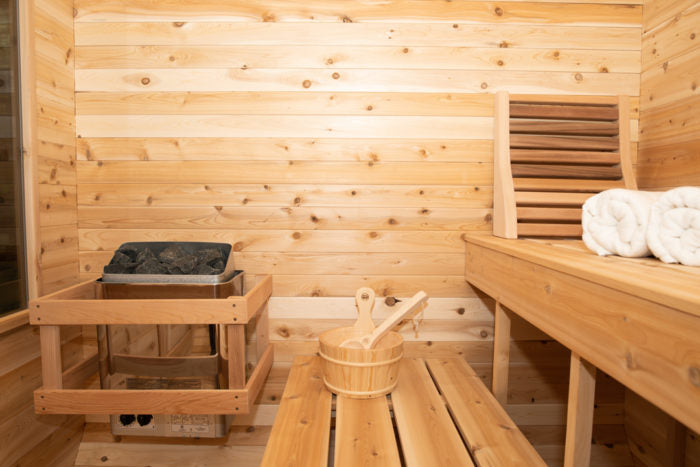Excitement About Traditional Sauna
Excitement About Traditional Sauna
Blog Article
The 10-Minute Rule for Traditional Sauna
Table of ContentsThe Basic Principles Of Traditional Sauna The Traditional Sauna DiariesAn Unbiased View of Traditional SaunaThe Best Strategy To Use For Traditional Sauna
The majority of the weight shed in a sauna is water loss and is re-gained upon rehydrating. However, undeniably sauna can be an integral part of a healthy and balanced fat burning program. To look at the differences between conventional and IR saunas, I will separate these into proven, theoretical, and produced distinctions.Thus, the hottest point in the saunawhich is at the ceiling straight above the sauna heateris commonly in between 185 and 190 F. Traditional Sauna. Claims that a typical sauna goes beyond 200 F is simply not real and not relevant for electrical saunas marketed in the United States. The temperature level for a far-infrared sauna is generally established between 120 and 140 F; nonetheless, unlike the standard sauna, the goal in and IR area is not to accomplish a heat
Due to this, the temperature level distinction is nearly unnecessary, given that profuse sweating causes both sauna kinds, however the technique of heating the body is various. In an IR sauna the bather will really feel hot and will sweat profusely, yet at a lot lower temperatures. Thus, if the objective is to spend longer durations of time in the sauna, the IR sauna is a good selection.

Traditional Sauna Can Be Fun For Anyone
When the high temperature level is achieved, the aspects cycle on and off to keep the high temperature level. Most standard sauna users take pleasure in putting water over the rocks to produce heavy steam to increase sauna humidity levels. The benefits of pouring water over the rocks include: making the room much more comfortable, moistening the nasal flows, and allowing the use of aromatherapy by mixing important oils with the water.
In a far-infrared sauna, the warm waves permeate the body to successfully warm the body and elevate the body core temperature level. To attain this raised temperature level, Far-infrared emitters develop infrared power which is close to the very same wavelength as that which the body normally emitsoften referred to as the "Vital Range" of 7 to 14 microns), so the power is well obtained by the body.
When the power gets in the body, it creates the body temperature level to raise and eventually leads to sweat. In an infrared sauna it is essential for the emitters/heaters to stay on almost frequently. Given that there is no mass of rocks to keep heat, the sauna will certainly cool down if the emitters closed off.
As stated over, the sauna bather in an infrared click room wants to position himself in front of operating emitters to get maximum gain from the warm. The heating time for both spaces can be extremely different, depending on just how the spaces are made use of. For a typical sauna, a bather ought to enable 30-40 mins for the space to accomplish a wanted temperature level and to appropriately pre-heat the rocks.
Fascination About Traditional Sauna
A well built sauna will usually achieve site link a temperature of 150-160 F in concerning 30-40 mins (Traditional Sauna). For hotter temperatures, the space might need to warm for a longer duration. When the area accomplishes established temperature, the heater will certainly cycle on and off, usually operating concerning 50% of the time. The shielded walls and the heated rocks will certainly keep the space warm and at secure temperatures.
To some, 15 mins was "lost" while the infrared energy heated up the timber panels as opposed to heating up a body, while others locate a pre-heated area to be much more comfy and think an elevated starting temperature is needed to start sweating. The size of recommended usage for each and every area is roughly the same (10-15 minutes per session); nonetheless, because of the reduced air temperatures and the capacity to really feel the results of infrared warmth quicker than a traditional sauna, it is not uncommon for a person to invest a total of 20-30 minutes in an infrared sauna.
Standard saunas have a tendency to be bigger (hence use more electrical power) than infrared saunas, although typical saunas are definitely offered in one and 2 person dimensions. For a two-person typical sauna, 5x6 or 5x7 dimension is most prominent. The leading bench can conveniently seat two or three individuals and is additionally enough time to rest during the sauna session.


The average price per kWH of electrical power in the U.S. is approximately $0.11, so a 4.5 kW heater will set you back about $.50 to run for one hour, if the heating unit runs helpful resources continuously for one hour. Normally a sauna heater will certainly run for 75% of the very first hour and 50% of subsequent hours on given that the aspects cycle once the established temperature is attained.
Some Known Factual Statements About Traditional Sauna
A two person far-infrared space is usually physically smaller sized than a standard sauna, usually regarding 4' x 4' or smaller sized. The IR heating system is normally 1.5-1.7 kW making use of a 120 volt 15 amp plug-in service. Given that the space can be used faster than a sauna space, we will think the space is used for to of an hour including warm up time.
There is a rarely gone over distinction in the social experience in between the two areas. While our culture has shed some of the social advantage of the conventional sauna experience, it can be very socially gratifying. From family time in the sauna, to heart-felt conversations with substantial others, to sauna partiesthe conventional sauna experience can result in intimate interacting socially.
Most higher end infrared rooms consist of colored light treatment, noise systems and full-glass fronts.
Report this page